Macroeconomic Factors for Tobacco Business in China: Analysis Report
VerifiedAdded on 2021/05/31
|34
|9156
|31
Report
AI Summary
This report assesses the suitability of China as a location for a tobacco products manufacturing business. It begins with an executive summary, followed by an introduction outlining the paper's objectives, which is to determine if China is a favorable nation for starting a tobacco business. The paper analyzes various macroeconomic variables, including economic growth, unemployment, wage rates, human capital, inflation, interest rates, domestic credit, taxation policies, and exchange rate regimes. The report also examines the general business environment in China, the impact of the global financial crisis (GFC), and the ease of doing business for foreign investors. The analysis reveals that China's current economic performance presents challenges for new business startups. The report discusses the difficulties faced by foreign investors, including regulatory hurdles, limited business structures, and high production costs. Based on these findings, the report concludes that, despite China's potential for future growth, the current business environment is not ideal for the proposed business venture, while acknowledging that the economy is developing programs which are encouraging foreign investment.
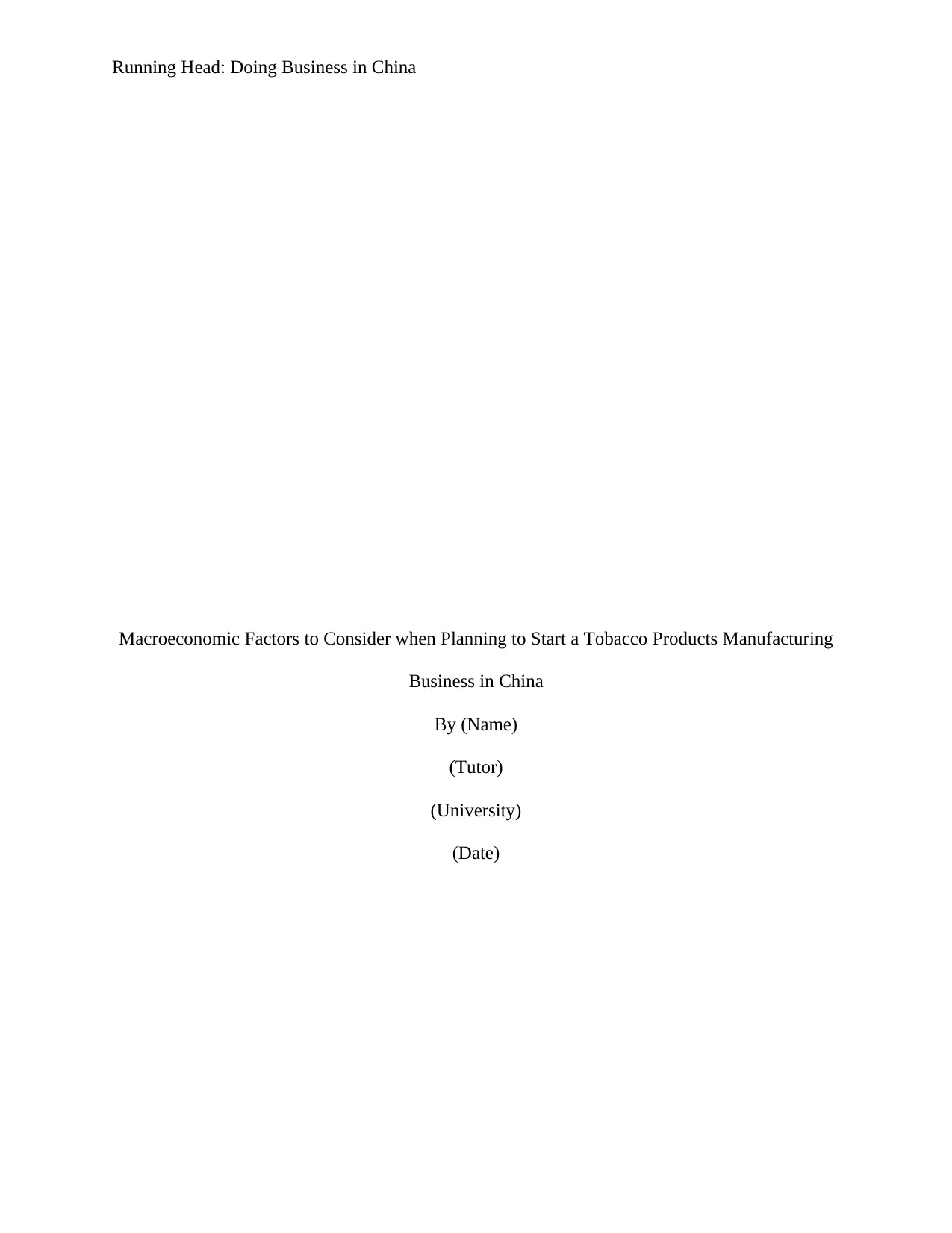
Running Head: Doing Business in China
Macroeconomic Factors to Consider when Planning to Start a Tobacco Products Manufacturing
Business in China
By (Name)
(Tutor)
(University)
(Date)
Macroeconomic Factors to Consider when Planning to Start a Tobacco Products Manufacturing
Business in China
By (Name)
(Tutor)
(University)
(Date)
Paraphrase This Document
Need a fresh take? Get an instant paraphrase of this document with our AI Paraphraser
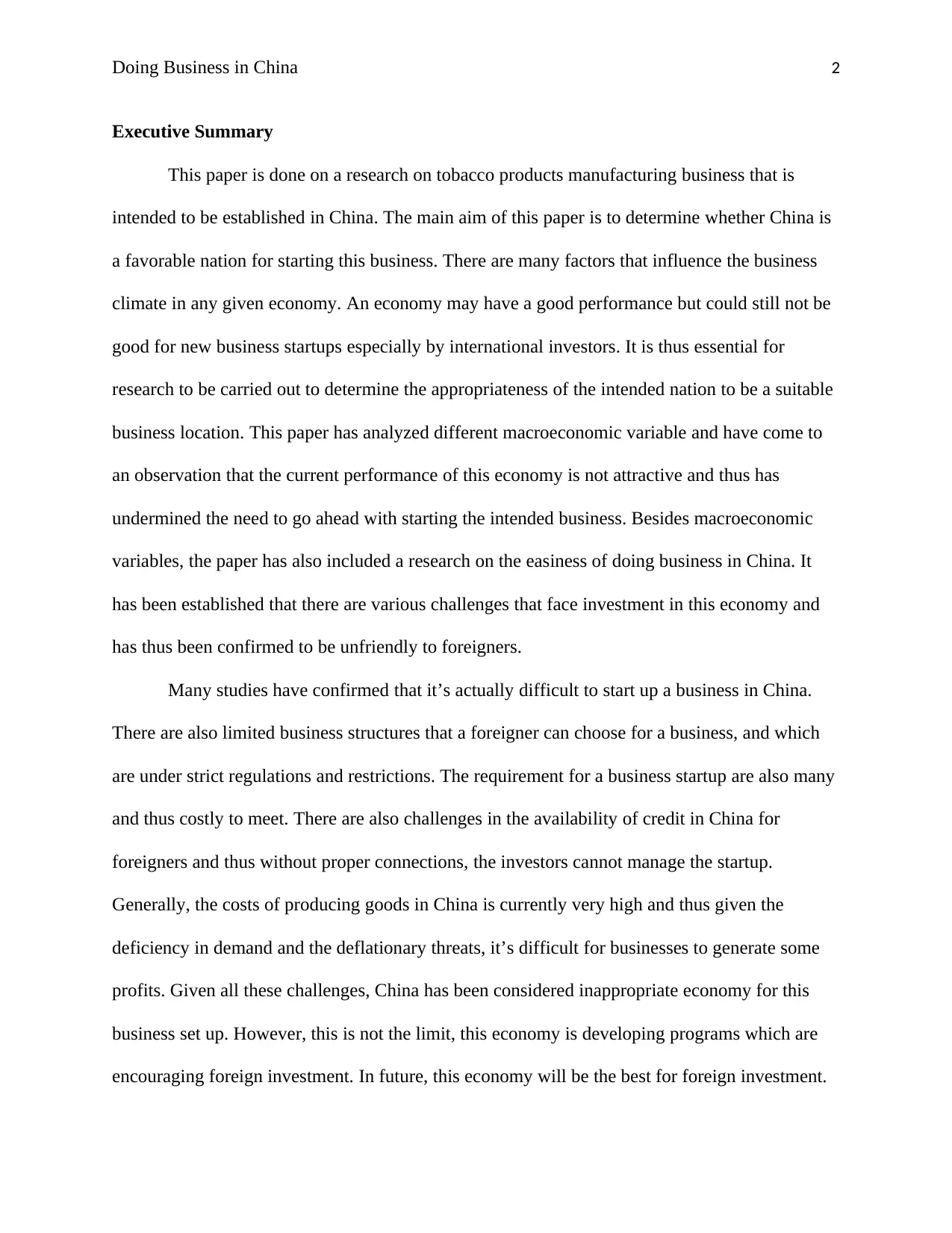
Doing Business in China 2
Executive Summary
This paper is done on a research on tobacco products manufacturing business that is
intended to be established in China. The main aim of this paper is to determine whether China is
a favorable nation for starting this business. There are many factors that influence the business
climate in any given economy. An economy may have a good performance but could still not be
good for new business startups especially by international investors. It is thus essential for
research to be carried out to determine the appropriateness of the intended nation to be a suitable
business location. This paper has analyzed different macroeconomic variable and have come to
an observation that the current performance of this economy is not attractive and thus has
undermined the need to go ahead with starting the intended business. Besides macroeconomic
variables, the paper has also included a research on the easiness of doing business in China. It
has been established that there are various challenges that face investment in this economy and
has thus been confirmed to be unfriendly to foreigners.
Many studies have confirmed that it’s actually difficult to start up a business in China.
There are also limited business structures that a foreigner can choose for a business, and which
are under strict regulations and restrictions. The requirement for a business startup are also many
and thus costly to meet. There are also challenges in the availability of credit in China for
foreigners and thus without proper connections, the investors cannot manage the startup.
Generally, the costs of producing goods in China is currently very high and thus given the
deficiency in demand and the deflationary threats, it’s difficult for businesses to generate some
profits. Given all these challenges, China has been considered inappropriate economy for this
business set up. However, this is not the limit, this economy is developing programs which are
encouraging foreign investment. In future, this economy will be the best for foreign investment.
Executive Summary
This paper is done on a research on tobacco products manufacturing business that is
intended to be established in China. The main aim of this paper is to determine whether China is
a favorable nation for starting this business. There are many factors that influence the business
climate in any given economy. An economy may have a good performance but could still not be
good for new business startups especially by international investors. It is thus essential for
research to be carried out to determine the appropriateness of the intended nation to be a suitable
business location. This paper has analyzed different macroeconomic variable and have come to
an observation that the current performance of this economy is not attractive and thus has
undermined the need to go ahead with starting the intended business. Besides macroeconomic
variables, the paper has also included a research on the easiness of doing business in China. It
has been established that there are various challenges that face investment in this economy and
has thus been confirmed to be unfriendly to foreigners.
Many studies have confirmed that it’s actually difficult to start up a business in China.
There are also limited business structures that a foreigner can choose for a business, and which
are under strict regulations and restrictions. The requirement for a business startup are also many
and thus costly to meet. There are also challenges in the availability of credit in China for
foreigners and thus without proper connections, the investors cannot manage the startup.
Generally, the costs of producing goods in China is currently very high and thus given the
deficiency in demand and the deflationary threats, it’s difficult for businesses to generate some
profits. Given all these challenges, China has been considered inappropriate economy for this
business set up. However, this is not the limit, this economy is developing programs which are
encouraging foreign investment. In future, this economy will be the best for foreign investment.
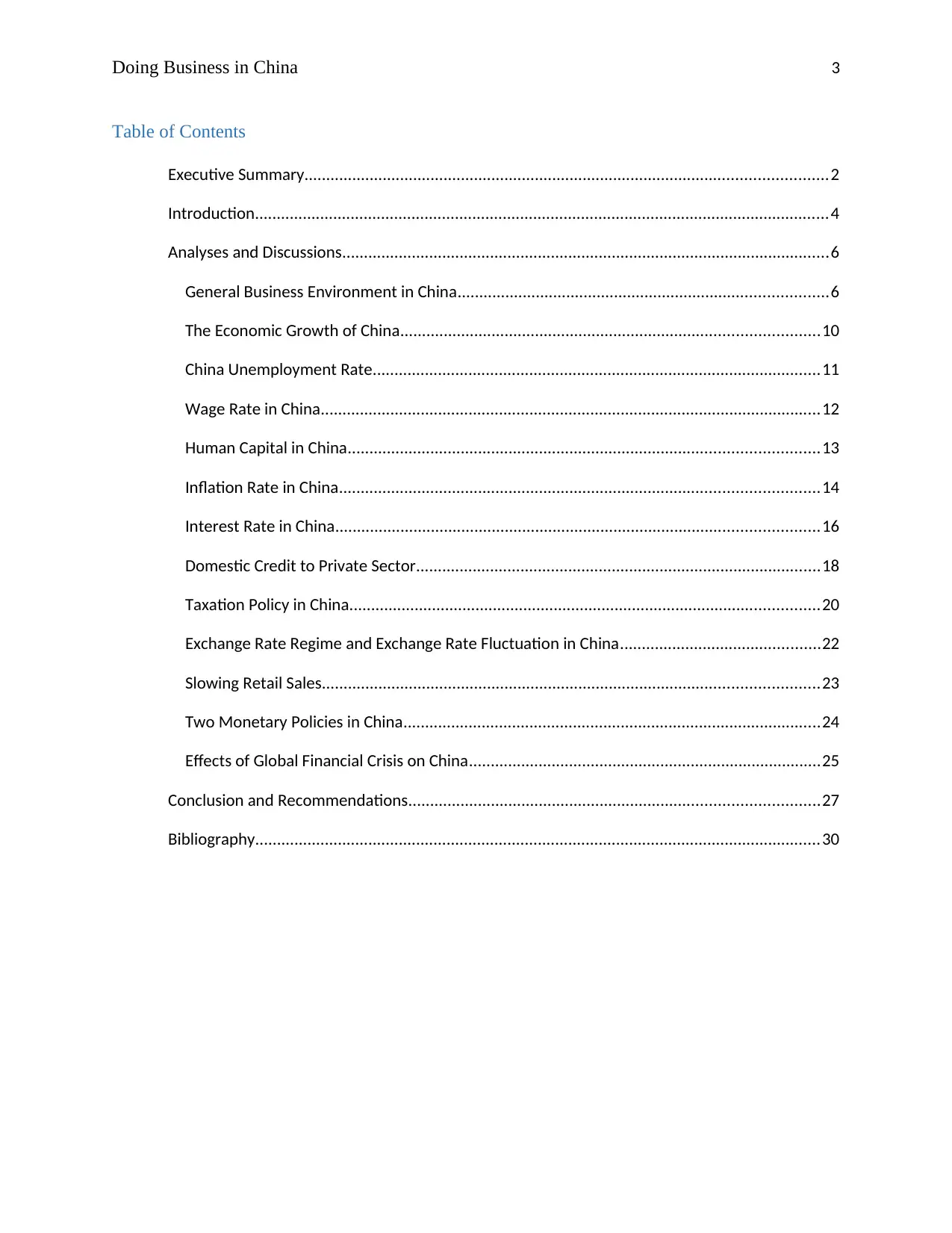
Doing Business in China 3
Table of Contents
Executive Summary........................................................................................................................2
Introduction....................................................................................................................................4
Analyses and Discussions................................................................................................................6
General Business Environment in China.....................................................................................6
The Economic Growth of China................................................................................................10
China Unemployment Rate.......................................................................................................11
Wage Rate in China...................................................................................................................12
Human Capital in China............................................................................................................13
Inflation Rate in China..............................................................................................................14
Interest Rate in China...............................................................................................................16
Domestic Credit to Private Sector.............................................................................................18
Taxation Policy in China............................................................................................................20
Exchange Rate Regime and Exchange Rate Fluctuation in China..............................................22
Slowing Retail Sales..................................................................................................................23
Two Monetary Policies in China................................................................................................24
Effects of Global Financial Crisis on China.................................................................................25
Conclusion and Recommendations..............................................................................................27
Bibliography..................................................................................................................................30
Table of Contents
Executive Summary........................................................................................................................2
Introduction....................................................................................................................................4
Analyses and Discussions................................................................................................................6
General Business Environment in China.....................................................................................6
The Economic Growth of China................................................................................................10
China Unemployment Rate.......................................................................................................11
Wage Rate in China...................................................................................................................12
Human Capital in China............................................................................................................13
Inflation Rate in China..............................................................................................................14
Interest Rate in China...............................................................................................................16
Domestic Credit to Private Sector.............................................................................................18
Taxation Policy in China............................................................................................................20
Exchange Rate Regime and Exchange Rate Fluctuation in China..............................................22
Slowing Retail Sales..................................................................................................................23
Two Monetary Policies in China................................................................................................24
Effects of Global Financial Crisis on China.................................................................................25
Conclusion and Recommendations..............................................................................................27
Bibliography..................................................................................................................................30
⊘ This is a preview!⊘
Do you want full access?
Subscribe today to unlock all pages.

Trusted by 1+ million students worldwide
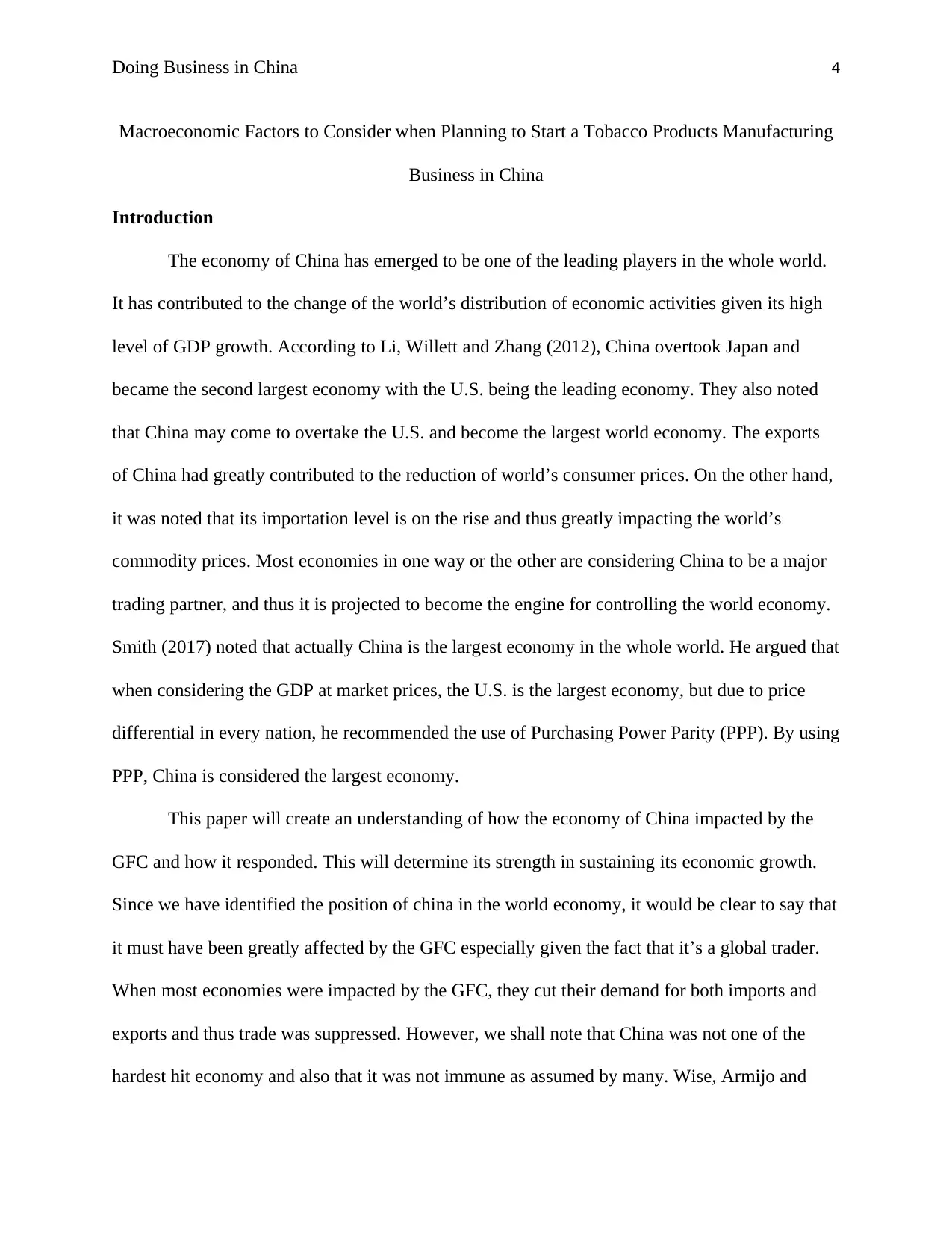
Doing Business in China 4
Macroeconomic Factors to Consider when Planning to Start a Tobacco Products Manufacturing
Business in China
Introduction
The economy of China has emerged to be one of the leading players in the whole world.
It has contributed to the change of the world’s distribution of economic activities given its high
level of GDP growth. According to Li, Willett and Zhang (2012), China overtook Japan and
became the second largest economy with the U.S. being the leading economy. They also noted
that China may come to overtake the U.S. and become the largest world economy. The exports
of China had greatly contributed to the reduction of world’s consumer prices. On the other hand,
it was noted that its importation level is on the rise and thus greatly impacting the world’s
commodity prices. Most economies in one way or the other are considering China to be a major
trading partner, and thus it is projected to become the engine for controlling the world economy.
Smith (2017) noted that actually China is the largest economy in the whole world. He argued that
when considering the GDP at market prices, the U.S. is the largest economy, but due to price
differential in every nation, he recommended the use of Purchasing Power Parity (PPP). By using
PPP, China is considered the largest economy.
This paper will create an understanding of how the economy of China impacted by the
GFC and how it responded. This will determine its strength in sustaining its economic growth.
Since we have identified the position of china in the world economy, it would be clear to say that
it must have been greatly affected by the GFC especially given the fact that it’s a global trader.
When most economies were impacted by the GFC, they cut their demand for both imports and
exports and thus trade was suppressed. However, we shall note that China was not one of the
hardest hit economy and also that it was not immune as assumed by many. Wise, Armijo and
Macroeconomic Factors to Consider when Planning to Start a Tobacco Products Manufacturing
Business in China
Introduction
The economy of China has emerged to be one of the leading players in the whole world.
It has contributed to the change of the world’s distribution of economic activities given its high
level of GDP growth. According to Li, Willett and Zhang (2012), China overtook Japan and
became the second largest economy with the U.S. being the leading economy. They also noted
that China may come to overtake the U.S. and become the largest world economy. The exports
of China had greatly contributed to the reduction of world’s consumer prices. On the other hand,
it was noted that its importation level is on the rise and thus greatly impacting the world’s
commodity prices. Most economies in one way or the other are considering China to be a major
trading partner, and thus it is projected to become the engine for controlling the world economy.
Smith (2017) noted that actually China is the largest economy in the whole world. He argued that
when considering the GDP at market prices, the U.S. is the largest economy, but due to price
differential in every nation, he recommended the use of Purchasing Power Parity (PPP). By using
PPP, China is considered the largest economy.
This paper will create an understanding of how the economy of China impacted by the
GFC and how it responded. This will determine its strength in sustaining its economic growth.
Since we have identified the position of china in the world economy, it would be clear to say that
it must have been greatly affected by the GFC especially given the fact that it’s a global trader.
When most economies were impacted by the GFC, they cut their demand for both imports and
exports and thus trade was suppressed. However, we shall note that China was not one of the
hardest hit economy and also that it was not immune as assumed by many. Wise, Armijo and
Paraphrase This Document
Need a fresh take? Get an instant paraphrase of this document with our AI Paraphraser
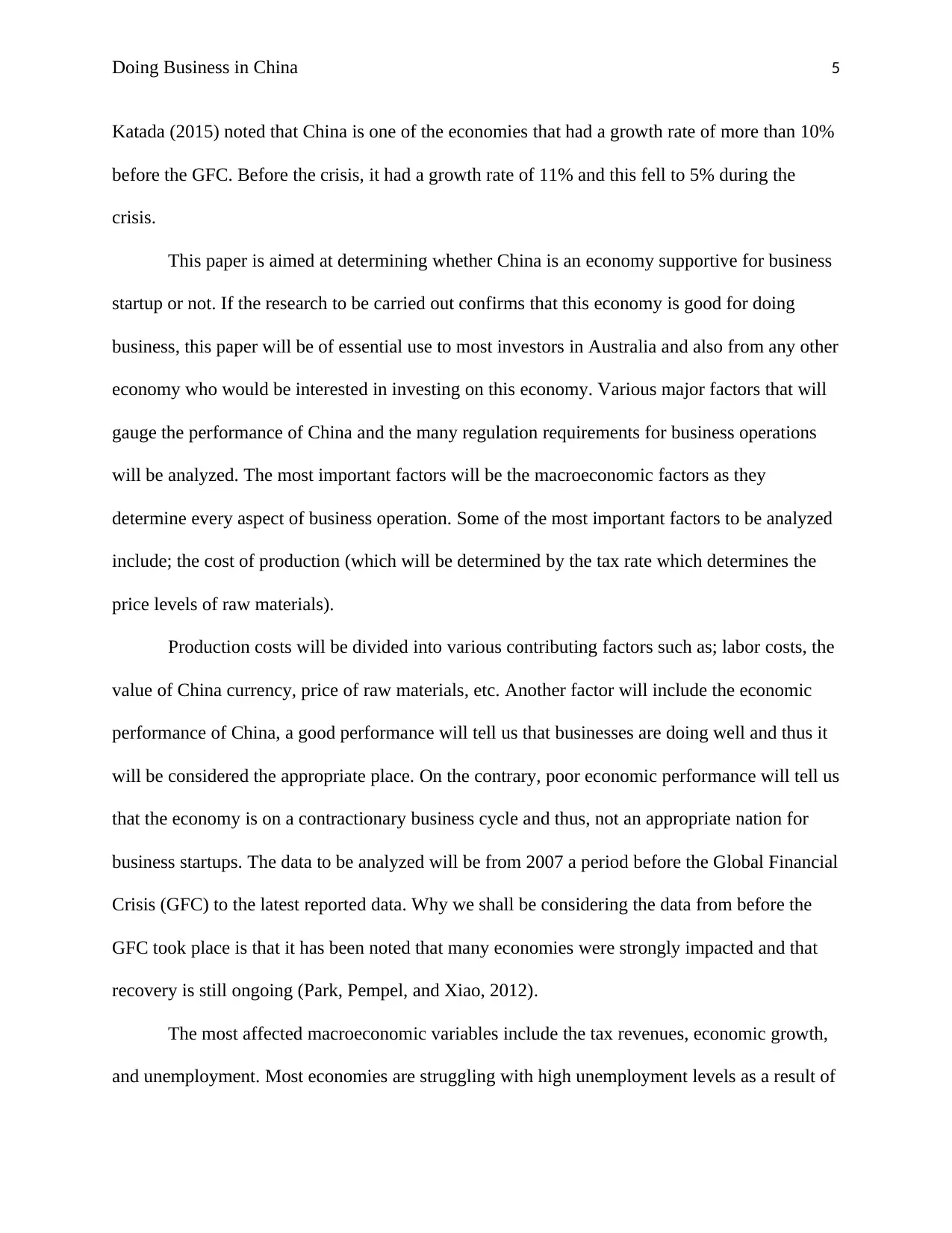
Doing Business in China 5
Katada (2015) noted that China is one of the economies that had a growth rate of more than 10%
before the GFC. Before the crisis, it had a growth rate of 11% and this fell to 5% during the
crisis.
This paper is aimed at determining whether China is an economy supportive for business
startup or not. If the research to be carried out confirms that this economy is good for doing
business, this paper will be of essential use to most investors in Australia and also from any other
economy who would be interested in investing on this economy. Various major factors that will
gauge the performance of China and the many regulation requirements for business operations
will be analyzed. The most important factors will be the macroeconomic factors as they
determine every aspect of business operation. Some of the most important factors to be analyzed
include; the cost of production (which will be determined by the tax rate which determines the
price levels of raw materials).
Production costs will be divided into various contributing factors such as; labor costs, the
value of China currency, price of raw materials, etc. Another factor will include the economic
performance of China, a good performance will tell us that businesses are doing well and thus it
will be considered the appropriate place. On the contrary, poor economic performance will tell us
that the economy is on a contractionary business cycle and thus, not an appropriate nation for
business startups. The data to be analyzed will be from 2007 a period before the Global Financial
Crisis (GFC) to the latest reported data. Why we shall be considering the data from before the
GFC took place is that it has been noted that many economies were strongly impacted and that
recovery is still ongoing (Park, Pempel, and Xiao, 2012).
The most affected macroeconomic variables include the tax revenues, economic growth,
and unemployment. Most economies are struggling with high unemployment levels as a result of
Katada (2015) noted that China is one of the economies that had a growth rate of more than 10%
before the GFC. Before the crisis, it had a growth rate of 11% and this fell to 5% during the
crisis.
This paper is aimed at determining whether China is an economy supportive for business
startup or not. If the research to be carried out confirms that this economy is good for doing
business, this paper will be of essential use to most investors in Australia and also from any other
economy who would be interested in investing on this economy. Various major factors that will
gauge the performance of China and the many regulation requirements for business operations
will be analyzed. The most important factors will be the macroeconomic factors as they
determine every aspect of business operation. Some of the most important factors to be analyzed
include; the cost of production (which will be determined by the tax rate which determines the
price levels of raw materials).
Production costs will be divided into various contributing factors such as; labor costs, the
value of China currency, price of raw materials, etc. Another factor will include the economic
performance of China, a good performance will tell us that businesses are doing well and thus it
will be considered the appropriate place. On the contrary, poor economic performance will tell us
that the economy is on a contractionary business cycle and thus, not an appropriate nation for
business startups. The data to be analyzed will be from 2007 a period before the Global Financial
Crisis (GFC) to the latest reported data. Why we shall be considering the data from before the
GFC took place is that it has been noted that many economies were strongly impacted and that
recovery is still ongoing (Park, Pempel, and Xiao, 2012).
The most affected macroeconomic variables include the tax revenues, economic growth,
and unemployment. Most economies are struggling with high unemployment levels as a result of
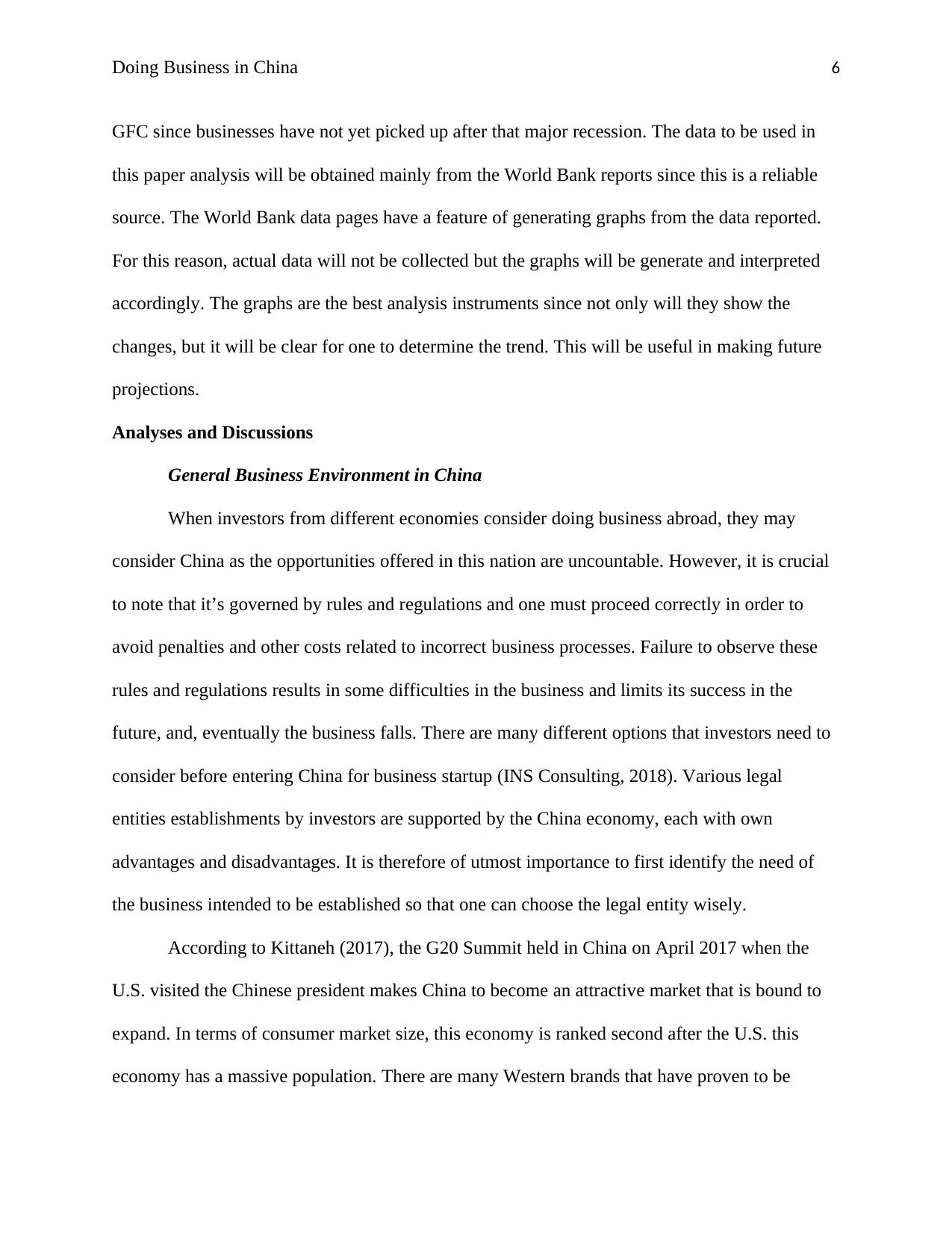
Doing Business in China 6
GFC since businesses have not yet picked up after that major recession. The data to be used in
this paper analysis will be obtained mainly from the World Bank reports since this is a reliable
source. The World Bank data pages have a feature of generating graphs from the data reported.
For this reason, actual data will not be collected but the graphs will be generate and interpreted
accordingly. The graphs are the best analysis instruments since not only will they show the
changes, but it will be clear for one to determine the trend. This will be useful in making future
projections.
Analyses and Discussions
General Business Environment in China
When investors from different economies consider doing business abroad, they may
consider China as the opportunities offered in this nation are uncountable. However, it is crucial
to note that it’s governed by rules and regulations and one must proceed correctly in order to
avoid penalties and other costs related to incorrect business processes. Failure to observe these
rules and regulations results in some difficulties in the business and limits its success in the
future, and, eventually the business falls. There are many different options that investors need to
consider before entering China for business startup (INS Consulting, 2018). Various legal
entities establishments by investors are supported by the China economy, each with own
advantages and disadvantages. It is therefore of utmost importance to first identify the need of
the business intended to be established so that one can choose the legal entity wisely.
According to Kittaneh (2017), the G20 Summit held in China on April 2017 when the
U.S. visited the Chinese president makes China to become an attractive market that is bound to
expand. In terms of consumer market size, this economy is ranked second after the U.S. this
economy has a massive population. There are many Western brands that have proven to be
GFC since businesses have not yet picked up after that major recession. The data to be used in
this paper analysis will be obtained mainly from the World Bank reports since this is a reliable
source. The World Bank data pages have a feature of generating graphs from the data reported.
For this reason, actual data will not be collected but the graphs will be generate and interpreted
accordingly. The graphs are the best analysis instruments since not only will they show the
changes, but it will be clear for one to determine the trend. This will be useful in making future
projections.
Analyses and Discussions
General Business Environment in China
When investors from different economies consider doing business abroad, they may
consider China as the opportunities offered in this nation are uncountable. However, it is crucial
to note that it’s governed by rules and regulations and one must proceed correctly in order to
avoid penalties and other costs related to incorrect business processes. Failure to observe these
rules and regulations results in some difficulties in the business and limits its success in the
future, and, eventually the business falls. There are many different options that investors need to
consider before entering China for business startup (INS Consulting, 2018). Various legal
entities establishments by investors are supported by the China economy, each with own
advantages and disadvantages. It is therefore of utmost importance to first identify the need of
the business intended to be established so that one can choose the legal entity wisely.
According to Kittaneh (2017), the G20 Summit held in China on April 2017 when the
U.S. visited the Chinese president makes China to become an attractive market that is bound to
expand. In terms of consumer market size, this economy is ranked second after the U.S. this
economy has a massive population. There are many Western brands that have proven to be
⊘ This is a preview!⊘
Do you want full access?
Subscribe today to unlock all pages.

Trusted by 1+ million students worldwide
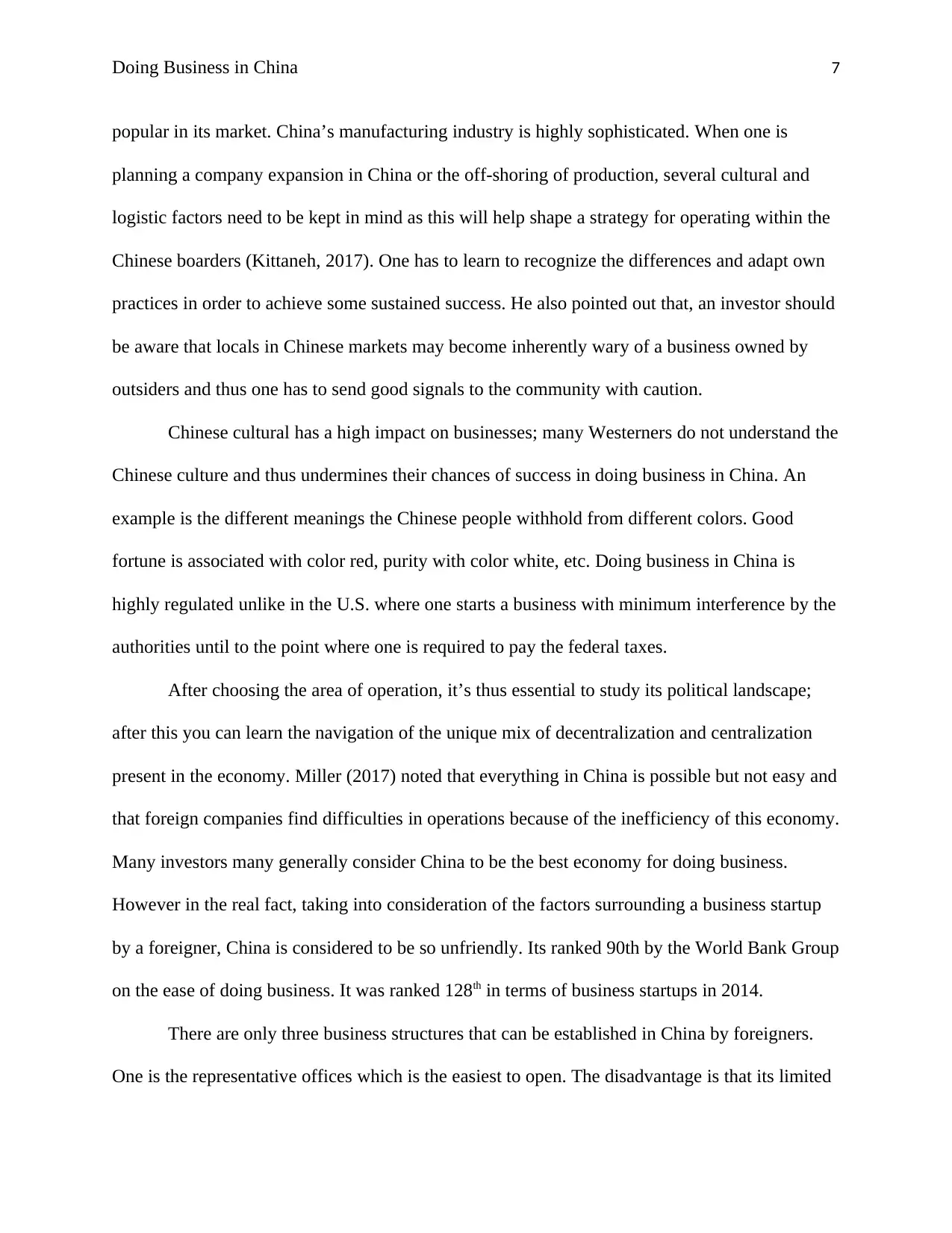
Doing Business in China 7
popular in its market. China’s manufacturing industry is highly sophisticated. When one is
planning a company expansion in China or the off-shoring of production, several cultural and
logistic factors need to be kept in mind as this will help shape a strategy for operating within the
Chinese boarders (Kittaneh, 2017). One has to learn to recognize the differences and adapt own
practices in order to achieve some sustained success. He also pointed out that, an investor should
be aware that locals in Chinese markets may become inherently wary of a business owned by
outsiders and thus one has to send good signals to the community with caution.
Chinese cultural has a high impact on businesses; many Westerners do not understand the
Chinese culture and thus undermines their chances of success in doing business in China. An
example is the different meanings the Chinese people withhold from different colors. Good
fortune is associated with color red, purity with color white, etc. Doing business in China is
highly regulated unlike in the U.S. where one starts a business with minimum interference by the
authorities until to the point where one is required to pay the federal taxes.
After choosing the area of operation, it’s thus essential to study its political landscape;
after this you can learn the navigation of the unique mix of decentralization and centralization
present in the economy. Miller (2017) noted that everything in China is possible but not easy and
that foreign companies find difficulties in operations because of the inefficiency of this economy.
Many investors many generally consider China to be the best economy for doing business.
However in the real fact, taking into consideration of the factors surrounding a business startup
by a foreigner, China is considered to be so unfriendly. Its ranked 90th by the World Bank Group
on the ease of doing business. It was ranked 128th in terms of business startups in 2014.
There are only three business structures that can be established in China by foreigners.
One is the representative offices which is the easiest to open. The disadvantage is that its limited
popular in its market. China’s manufacturing industry is highly sophisticated. When one is
planning a company expansion in China or the off-shoring of production, several cultural and
logistic factors need to be kept in mind as this will help shape a strategy for operating within the
Chinese boarders (Kittaneh, 2017). One has to learn to recognize the differences and adapt own
practices in order to achieve some sustained success. He also pointed out that, an investor should
be aware that locals in Chinese markets may become inherently wary of a business owned by
outsiders and thus one has to send good signals to the community with caution.
Chinese cultural has a high impact on businesses; many Westerners do not understand the
Chinese culture and thus undermines their chances of success in doing business in China. An
example is the different meanings the Chinese people withhold from different colors. Good
fortune is associated with color red, purity with color white, etc. Doing business in China is
highly regulated unlike in the U.S. where one starts a business with minimum interference by the
authorities until to the point where one is required to pay the federal taxes.
After choosing the area of operation, it’s thus essential to study its political landscape;
after this you can learn the navigation of the unique mix of decentralization and centralization
present in the economy. Miller (2017) noted that everything in China is possible but not easy and
that foreign companies find difficulties in operations because of the inefficiency of this economy.
Many investors many generally consider China to be the best economy for doing business.
However in the real fact, taking into consideration of the factors surrounding a business startup
by a foreigner, China is considered to be so unfriendly. Its ranked 90th by the World Bank Group
on the ease of doing business. It was ranked 128th in terms of business startups in 2014.
There are only three business structures that can be established in China by foreigners.
One is the representative offices which is the easiest to open. The disadvantage is that its limited
Paraphrase This Document
Need a fresh take? Get an instant paraphrase of this document with our AI Paraphraser
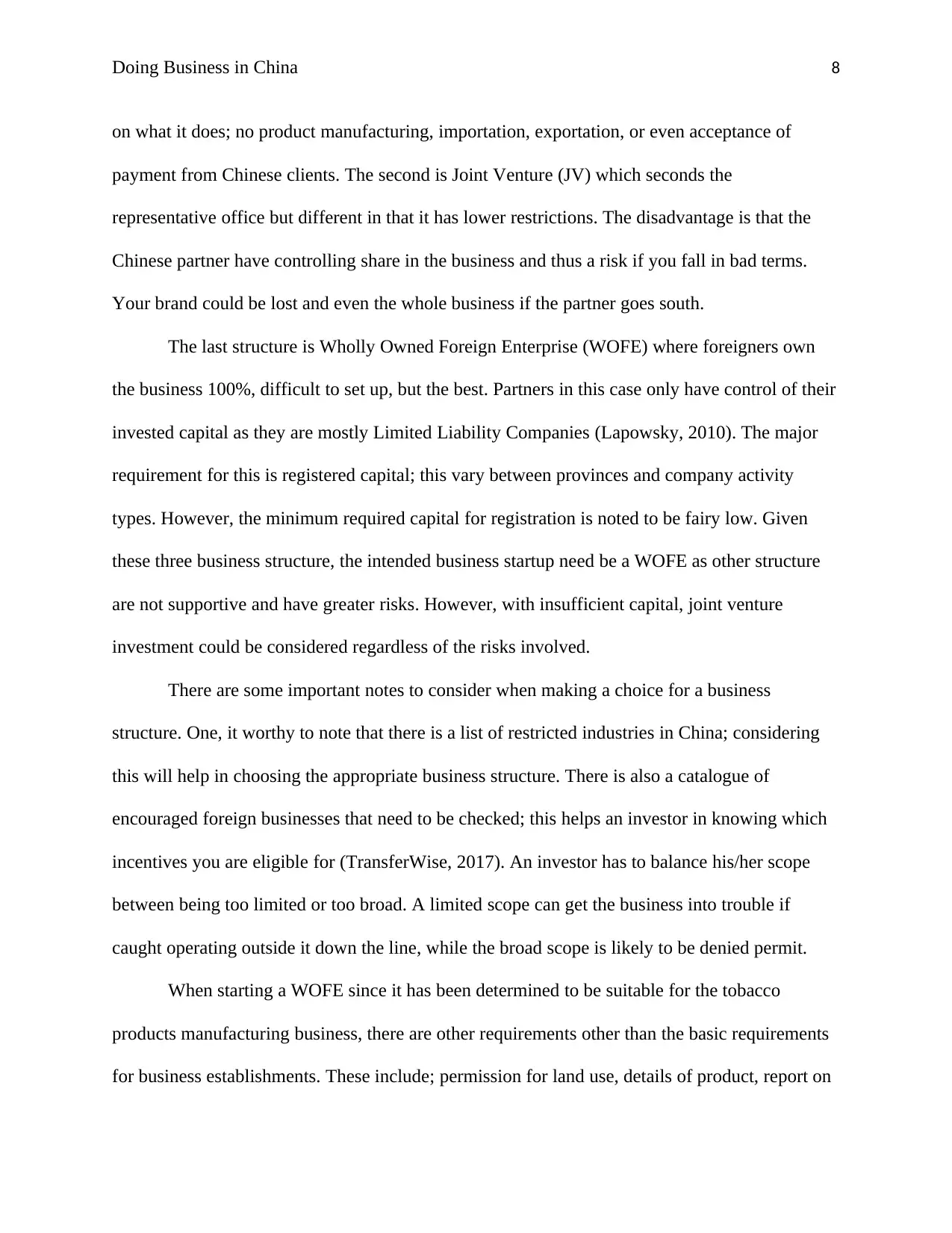
Doing Business in China 8
on what it does; no product manufacturing, importation, exportation, or even acceptance of
payment from Chinese clients. The second is Joint Venture (JV) which seconds the
representative office but different in that it has lower restrictions. The disadvantage is that the
Chinese partner have controlling share in the business and thus a risk if you fall in bad terms.
Your brand could be lost and even the whole business if the partner goes south.
The last structure is Wholly Owned Foreign Enterprise (WOFE) where foreigners own
the business 100%, difficult to set up, but the best. Partners in this case only have control of their
invested capital as they are mostly Limited Liability Companies (Lapowsky, 2010). The major
requirement for this is registered capital; this vary between provinces and company activity
types. However, the minimum required capital for registration is noted to be fairy low. Given
these three business structure, the intended business startup need be a WOFE as other structure
are not supportive and have greater risks. However, with insufficient capital, joint venture
investment could be considered regardless of the risks involved.
There are some important notes to consider when making a choice for a business
structure. One, it worthy to note that there is a list of restricted industries in China; considering
this will help in choosing the appropriate business structure. There is also a catalogue of
encouraged foreign businesses that need to be checked; this helps an investor in knowing which
incentives you are eligible for (TransferWise, 2017). An investor has to balance his/her scope
between being too limited or too broad. A limited scope can get the business into trouble if
caught operating outside it down the line, while the broad scope is likely to be denied permit.
When starting a WOFE since it has been determined to be suitable for the tobacco
products manufacturing business, there are other requirements other than the basic requirements
for business establishments. These include; permission for land use, details of product, report on
on what it does; no product manufacturing, importation, exportation, or even acceptance of
payment from Chinese clients. The second is Joint Venture (JV) which seconds the
representative office but different in that it has lower restrictions. The disadvantage is that the
Chinese partner have controlling share in the business and thus a risk if you fall in bad terms.
Your brand could be lost and even the whole business if the partner goes south.
The last structure is Wholly Owned Foreign Enterprise (WOFE) where foreigners own
the business 100%, difficult to set up, but the best. Partners in this case only have control of their
invested capital as they are mostly Limited Liability Companies (Lapowsky, 2010). The major
requirement for this is registered capital; this vary between provinces and company activity
types. However, the minimum required capital for registration is noted to be fairy low. Given
these three business structure, the intended business startup need be a WOFE as other structure
are not supportive and have greater risks. However, with insufficient capital, joint venture
investment could be considered regardless of the risks involved.
There are some important notes to consider when making a choice for a business
structure. One, it worthy to note that there is a list of restricted industries in China; considering
this will help in choosing the appropriate business structure. There is also a catalogue of
encouraged foreign businesses that need to be checked; this helps an investor in knowing which
incentives you are eligible for (TransferWise, 2017). An investor has to balance his/her scope
between being too limited or too broad. A limited scope can get the business into trouble if
caught operating outside it down the line, while the broad scope is likely to be denied permit.
When starting a WOFE since it has been determined to be suitable for the tobacco
products manufacturing business, there are other requirements other than the basic requirements
for business establishments. These include; permission for land use, details of product, report on
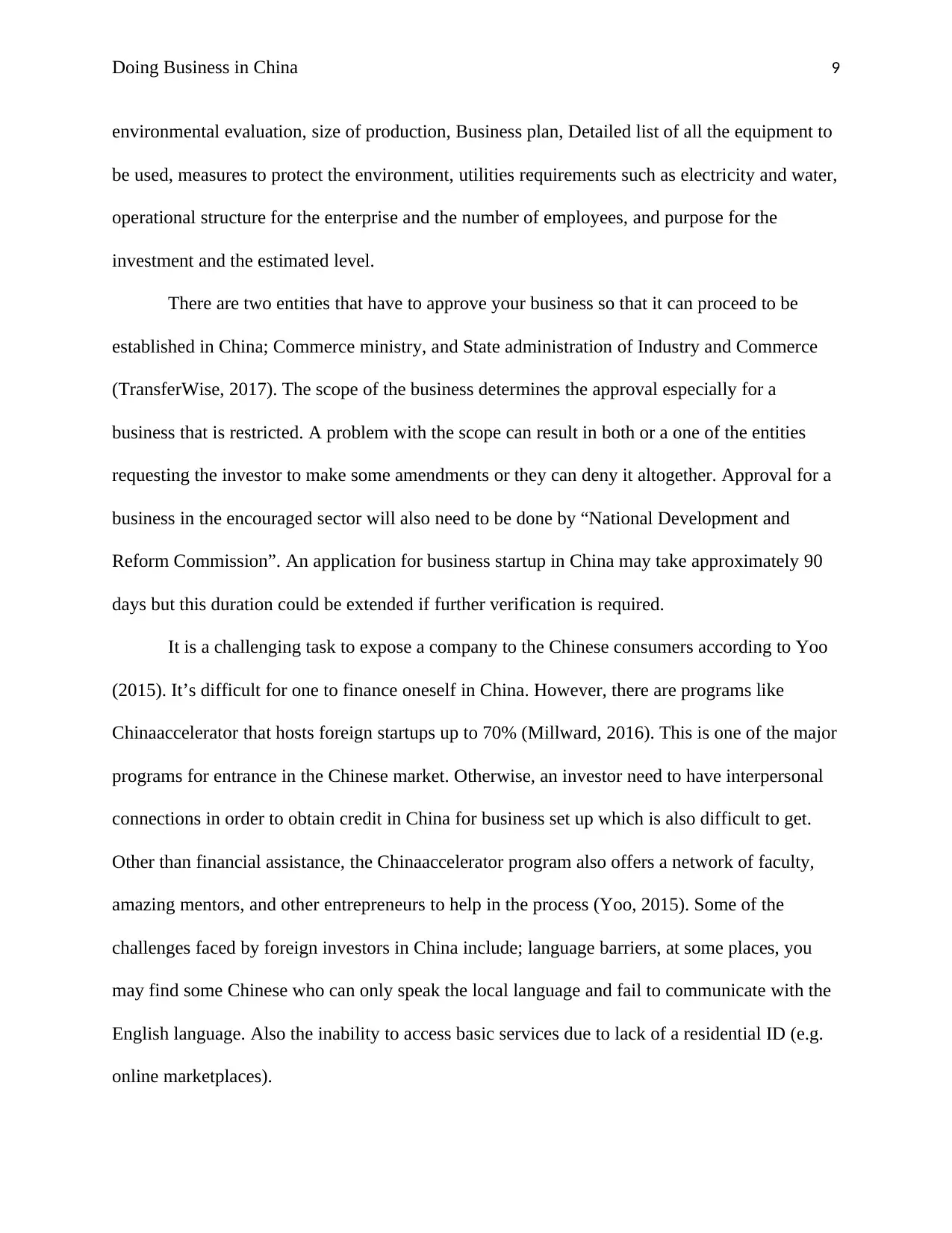
Doing Business in China 9
environmental evaluation, size of production, Business plan, Detailed list of all the equipment to
be used, measures to protect the environment, utilities requirements such as electricity and water,
operational structure for the enterprise and the number of employees, and purpose for the
investment and the estimated level.
There are two entities that have to approve your business so that it can proceed to be
established in China; Commerce ministry, and State administration of Industry and Commerce
(TransferWise, 2017). The scope of the business determines the approval especially for a
business that is restricted. A problem with the scope can result in both or a one of the entities
requesting the investor to make some amendments or they can deny it altogether. Approval for a
business in the encouraged sector will also need to be done by “National Development and
Reform Commission”. An application for business startup in China may take approximately 90
days but this duration could be extended if further verification is required.
It is a challenging task to expose a company to the Chinese consumers according to Yoo
(2015). It’s difficult for one to finance oneself in China. However, there are programs like
Chinaaccelerator that hosts foreign startups up to 70% (Millward, 2016). This is one of the major
programs for entrance in the Chinese market. Otherwise, an investor need to have interpersonal
connections in order to obtain credit in China for business set up which is also difficult to get.
Other than financial assistance, the Chinaaccelerator program also offers a network of faculty,
amazing mentors, and other entrepreneurs to help in the process (Yoo, 2015). Some of the
challenges faced by foreign investors in China include; language barriers, at some places, you
may find some Chinese who can only speak the local language and fail to communicate with the
English language. Also the inability to access basic services due to lack of a residential ID (e.g.
online marketplaces).
environmental evaluation, size of production, Business plan, Detailed list of all the equipment to
be used, measures to protect the environment, utilities requirements such as electricity and water,
operational structure for the enterprise and the number of employees, and purpose for the
investment and the estimated level.
There are two entities that have to approve your business so that it can proceed to be
established in China; Commerce ministry, and State administration of Industry and Commerce
(TransferWise, 2017). The scope of the business determines the approval especially for a
business that is restricted. A problem with the scope can result in both or a one of the entities
requesting the investor to make some amendments or they can deny it altogether. Approval for a
business in the encouraged sector will also need to be done by “National Development and
Reform Commission”. An application for business startup in China may take approximately 90
days but this duration could be extended if further verification is required.
It is a challenging task to expose a company to the Chinese consumers according to Yoo
(2015). It’s difficult for one to finance oneself in China. However, there are programs like
Chinaaccelerator that hosts foreign startups up to 70% (Millward, 2016). This is one of the major
programs for entrance in the Chinese market. Otherwise, an investor need to have interpersonal
connections in order to obtain credit in China for business set up which is also difficult to get.
Other than financial assistance, the Chinaaccelerator program also offers a network of faculty,
amazing mentors, and other entrepreneurs to help in the process (Yoo, 2015). Some of the
challenges faced by foreign investors in China include; language barriers, at some places, you
may find some Chinese who can only speak the local language and fail to communicate with the
English language. Also the inability to access basic services due to lack of a residential ID (e.g.
online marketplaces).
⊘ This is a preview!⊘
Do you want full access?
Subscribe today to unlock all pages.

Trusted by 1+ million students worldwide
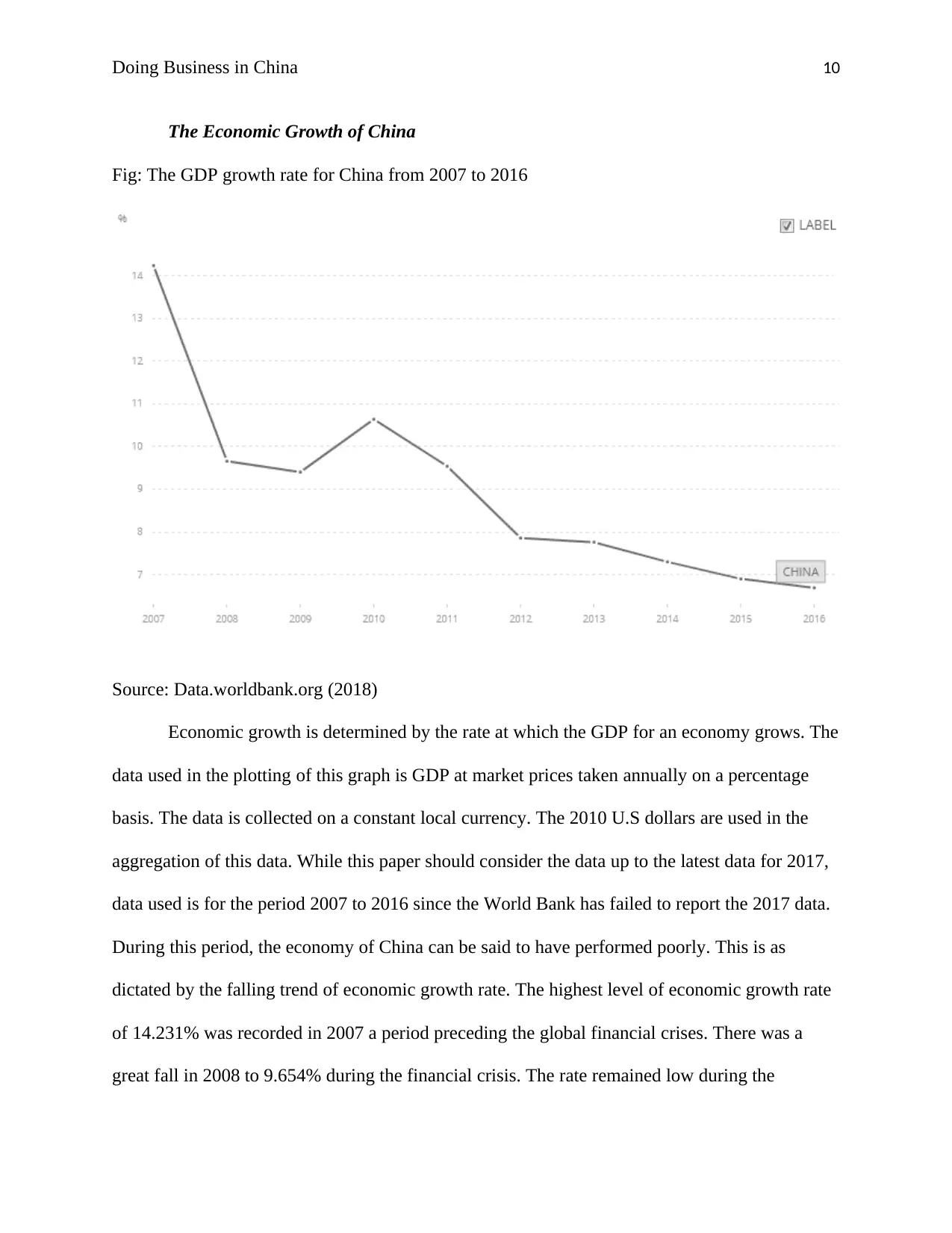
Doing Business in China 10
The Economic Growth of China
Fig: The GDP growth rate for China from 2007 to 2016
Source: Data.worldbank.org (2018)
Economic growth is determined by the rate at which the GDP for an economy grows. The
data used in the plotting of this graph is GDP at market prices taken annually on a percentage
basis. The data is collected on a constant local currency. The 2010 U.S dollars are used in the
aggregation of this data. While this paper should consider the data up to the latest data for 2017,
data used is for the period 2007 to 2016 since the World Bank has failed to report the 2017 data.
During this period, the economy of China can be said to have performed poorly. This is as
dictated by the falling trend of economic growth rate. The highest level of economic growth rate
of 14.231% was recorded in 2007 a period preceding the global financial crises. There was a
great fall in 2008 to 9.654% during the financial crisis. The rate remained low during the
The Economic Growth of China
Fig: The GDP growth rate for China from 2007 to 2016
Source: Data.worldbank.org (2018)
Economic growth is determined by the rate at which the GDP for an economy grows. The
data used in the plotting of this graph is GDP at market prices taken annually on a percentage
basis. The data is collected on a constant local currency. The 2010 U.S dollars are used in the
aggregation of this data. While this paper should consider the data up to the latest data for 2017,
data used is for the period 2007 to 2016 since the World Bank has failed to report the 2017 data.
During this period, the economy of China can be said to have performed poorly. This is as
dictated by the falling trend of economic growth rate. The highest level of economic growth rate
of 14.231% was recorded in 2007 a period preceding the global financial crises. There was a
great fall in 2008 to 9.654% during the financial crisis. The rate remained low during the
Paraphrase This Document
Need a fresh take? Get an instant paraphrase of this document with our AI Paraphraser
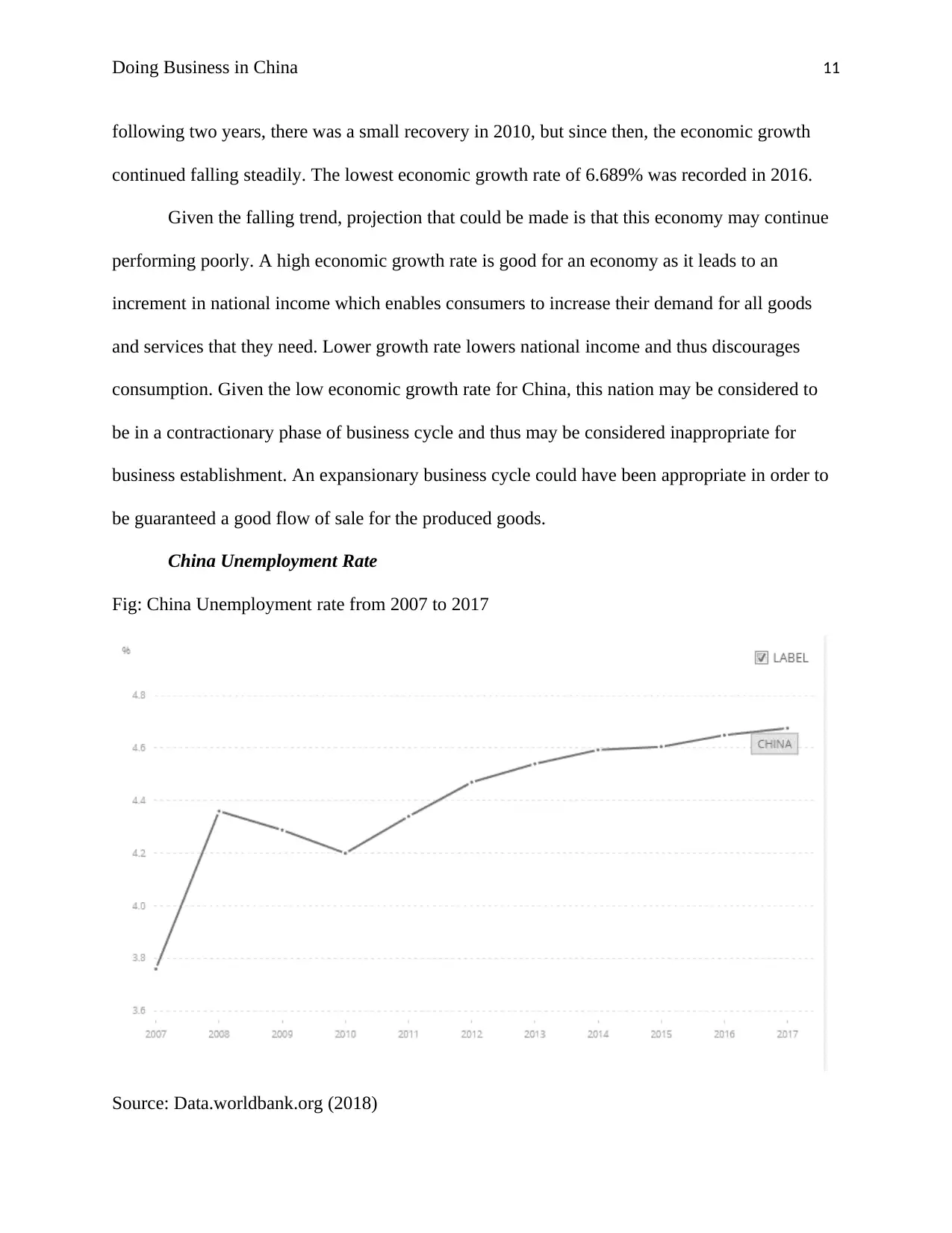
Doing Business in China 11
following two years, there was a small recovery in 2010, but since then, the economic growth
continued falling steadily. The lowest economic growth rate of 6.689% was recorded in 2016.
Given the falling trend, projection that could be made is that this economy may continue
performing poorly. A high economic growth rate is good for an economy as it leads to an
increment in national income which enables consumers to increase their demand for all goods
and services that they need. Lower growth rate lowers national income and thus discourages
consumption. Given the low economic growth rate for China, this nation may be considered to
be in a contractionary phase of business cycle and thus may be considered inappropriate for
business establishment. An expansionary business cycle could have been appropriate in order to
be guaranteed a good flow of sale for the produced goods.
China Unemployment Rate
Fig: China Unemployment rate from 2007 to 2017
Source: Data.worldbank.org (2018)
following two years, there was a small recovery in 2010, but since then, the economic growth
continued falling steadily. The lowest economic growth rate of 6.689% was recorded in 2016.
Given the falling trend, projection that could be made is that this economy may continue
performing poorly. A high economic growth rate is good for an economy as it leads to an
increment in national income which enables consumers to increase their demand for all goods
and services that they need. Lower growth rate lowers national income and thus discourages
consumption. Given the low economic growth rate for China, this nation may be considered to
be in a contractionary phase of business cycle and thus may be considered inappropriate for
business establishment. An expansionary business cycle could have been appropriate in order to
be guaranteed a good flow of sale for the produced goods.
China Unemployment Rate
Fig: China Unemployment rate from 2007 to 2017
Source: Data.worldbank.org (2018)
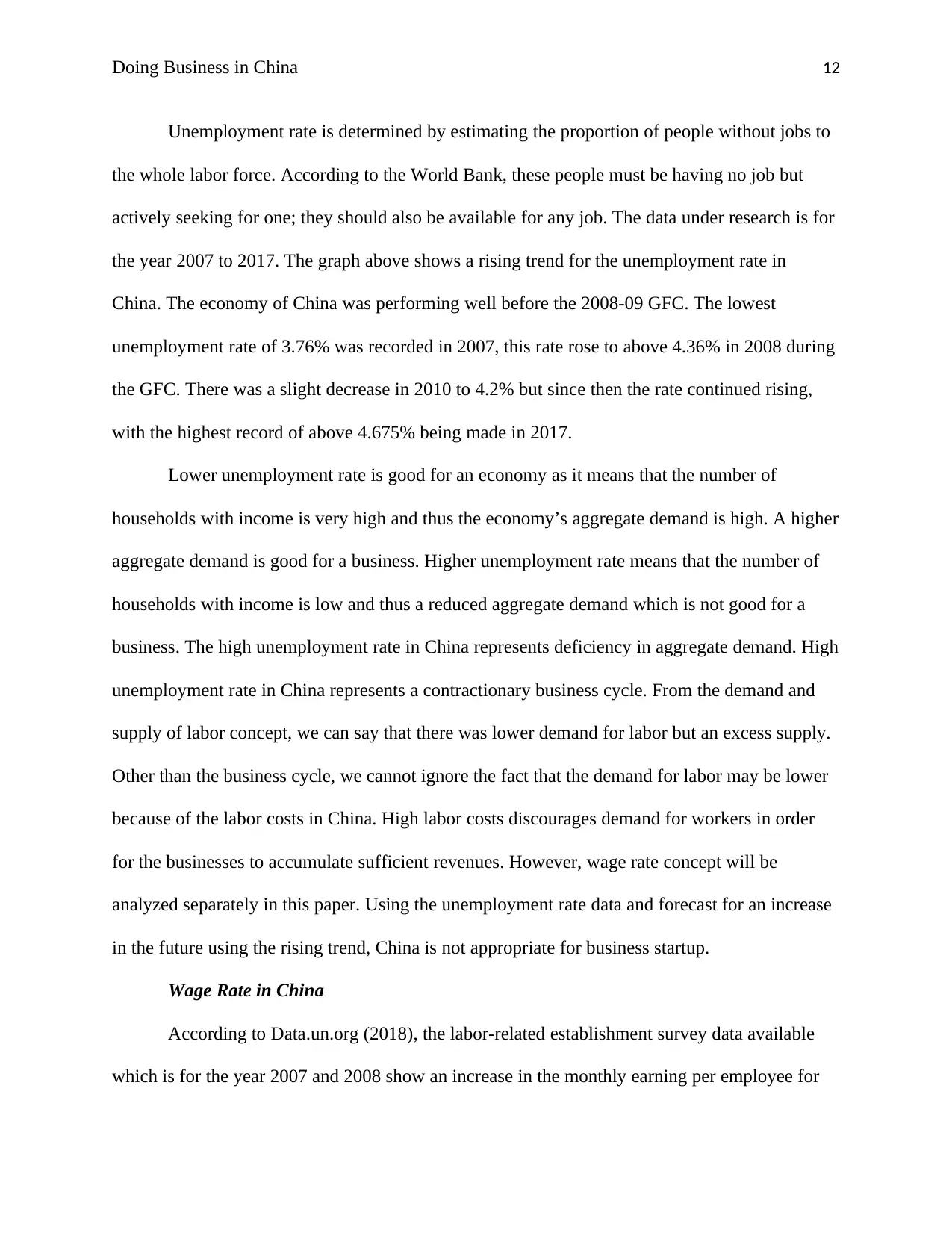
Doing Business in China 12
Unemployment rate is determined by estimating the proportion of people without jobs to
the whole labor force. According to the World Bank, these people must be having no job but
actively seeking for one; they should also be available for any job. The data under research is for
the year 2007 to 2017. The graph above shows a rising trend for the unemployment rate in
China. The economy of China was performing well before the 2008-09 GFC. The lowest
unemployment rate of 3.76% was recorded in 2007, this rate rose to above 4.36% in 2008 during
the GFC. There was a slight decrease in 2010 to 4.2% but since then the rate continued rising,
with the highest record of above 4.675% being made in 2017.
Lower unemployment rate is good for an economy as it means that the number of
households with income is very high and thus the economy’s aggregate demand is high. A higher
aggregate demand is good for a business. Higher unemployment rate means that the number of
households with income is low and thus a reduced aggregate demand which is not good for a
business. The high unemployment rate in China represents deficiency in aggregate demand. High
unemployment rate in China represents a contractionary business cycle. From the demand and
supply of labor concept, we can say that there was lower demand for labor but an excess supply.
Other than the business cycle, we cannot ignore the fact that the demand for labor may be lower
because of the labor costs in China. High labor costs discourages demand for workers in order
for the businesses to accumulate sufficient revenues. However, wage rate concept will be
analyzed separately in this paper. Using the unemployment rate data and forecast for an increase
in the future using the rising trend, China is not appropriate for business startup.
Wage Rate in China
According to Data.un.org (2018), the labor-related establishment survey data available
which is for the year 2007 and 2008 show an increase in the monthly earning per employee for
Unemployment rate is determined by estimating the proportion of people without jobs to
the whole labor force. According to the World Bank, these people must be having no job but
actively seeking for one; they should also be available for any job. The data under research is for
the year 2007 to 2017. The graph above shows a rising trend for the unemployment rate in
China. The economy of China was performing well before the 2008-09 GFC. The lowest
unemployment rate of 3.76% was recorded in 2007, this rate rose to above 4.36% in 2008 during
the GFC. There was a slight decrease in 2010 to 4.2% but since then the rate continued rising,
with the highest record of above 4.675% being made in 2017.
Lower unemployment rate is good for an economy as it means that the number of
households with income is very high and thus the economy’s aggregate demand is high. A higher
aggregate demand is good for a business. Higher unemployment rate means that the number of
households with income is low and thus a reduced aggregate demand which is not good for a
business. The high unemployment rate in China represents deficiency in aggregate demand. High
unemployment rate in China represents a contractionary business cycle. From the demand and
supply of labor concept, we can say that there was lower demand for labor but an excess supply.
Other than the business cycle, we cannot ignore the fact that the demand for labor may be lower
because of the labor costs in China. High labor costs discourages demand for workers in order
for the businesses to accumulate sufficient revenues. However, wage rate concept will be
analyzed separately in this paper. Using the unemployment rate data and forecast for an increase
in the future using the rising trend, China is not appropriate for business startup.
Wage Rate in China
According to Data.un.org (2018), the labor-related establishment survey data available
which is for the year 2007 and 2008 show an increase in the monthly earning per employee for
⊘ This is a preview!⊘
Do you want full access?
Subscribe today to unlock all pages.

Trusted by 1+ million students worldwide
1 out of 34
Related Documents
Your All-in-One AI-Powered Toolkit for Academic Success.
+13062052269
info@desklib.com
Available 24*7 on WhatsApp / Email
![[object Object]](/_next/static/media/star-bottom.7253800d.svg)
Unlock your academic potential
Copyright © 2020–2025 A2Z Services. All Rights Reserved. Developed and managed by ZUCOL.





